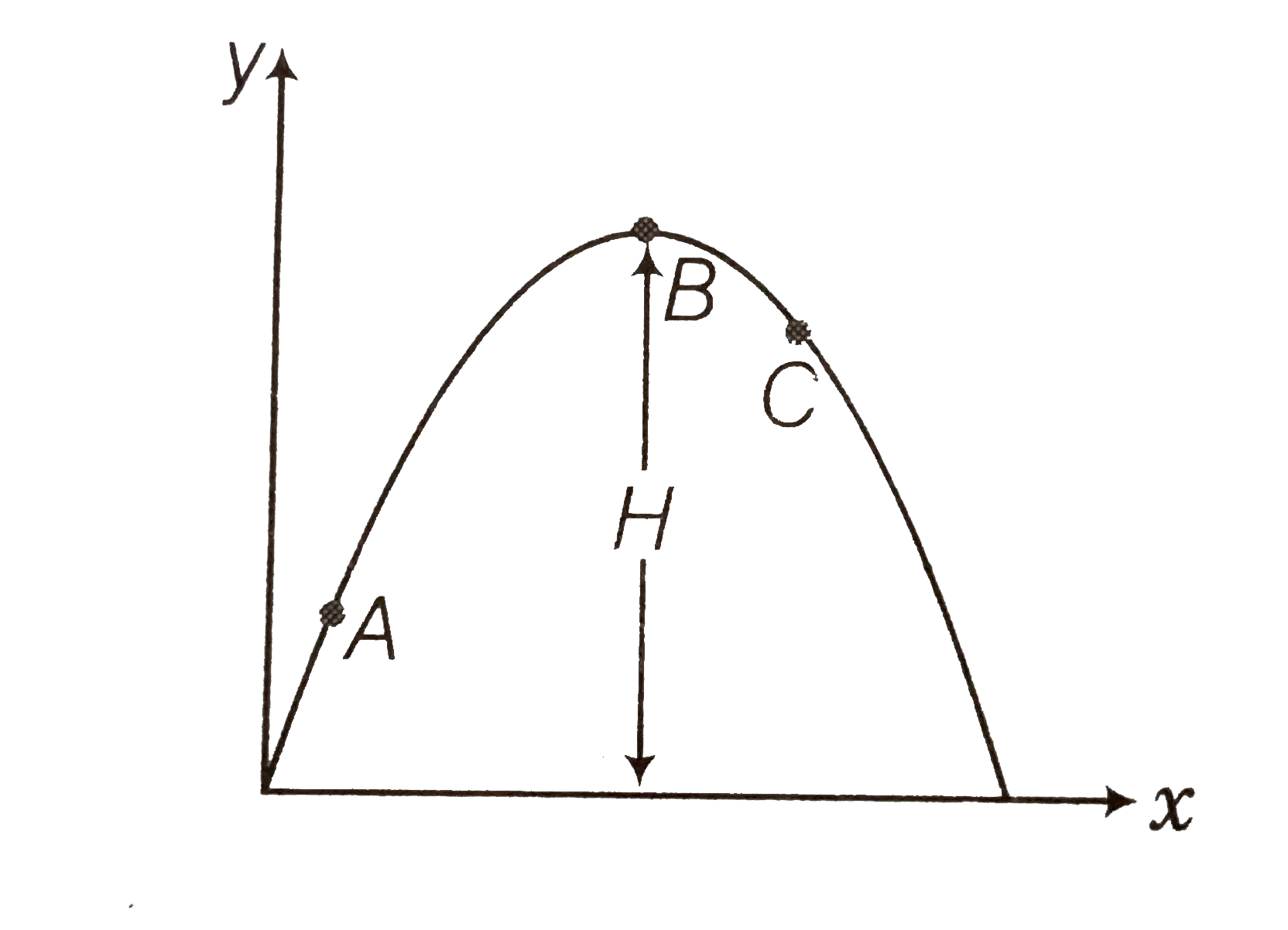A particle is projected from ground at some angle with horizontal (Assuming point of projection to the origin and the horizontal and vertical directions to be the x and y axis) the particle passes through the points (3, 4) m and (4, 3) m during its motion then the range of the particle would be : (g=10m/s2)
36 m
377 m
4 m
16 m
The correct Answer is:B
To solve the problem, we will use the equations of projectile motion. We know that the trajectory of a projectile can be described by the equation:
y=xtanθ−gx22v2cos2θ
where:
- y is the height,
- x is the horizontal distance,
- θ is the angle of projection,
- g is the acceleration due to gravity,
- v is the initial velocity.
Given that the particle passes through the points (3, 4) m and (4, 3) m, we can set up two equations based on these points.
Step 1: Set up the equations for the two points
For the point (3, 4):
4=3tanθ−g⋅322v2cos2θ
Substituting g=10m/s2:
4=3tanθ−10⋅92v2cos2θ
4=3tanθ−45v2cos2θ (Equation 1)
For the point (4, 3):
3=4tanθ−g⋅422v2cos2θ
Substituting g=10m/s2:
3=4tanθ−10⋅162v2cos2θ
3=4tanθ−80v2cos2θ (Equation 2)
Step 2: Solve the equations
Now we have two equations (1) and (2). We can eliminate tanθ by dividing these two equations.
Dividing Equation 1 by Equation 2:
43=3tanθ−45v2cos2θ4tanθ−80v2cos2θ
Cross-multiplying gives:
4(4tanθ−80v2cos2θ)=3(3tanθ−45v2cos2θ)
Expanding both sides:
16tanθ−320v2cos2θ=9tanθ−135v2cos2θ
Rearranging gives:
7tanθ=320−135v2cos2θ
7tanθ=185v2cos2θ
Step 3: Substitute back to find the range
Now we can express tanθ in terms of v:
tanθ=1857v2cos2θ
Using the range formula:
R=v2sin2θg
where sin2θ=2sinθcosθ.
Using the identity tanθ=sinθcosθ:
sinθ=tanθcosθ
Substituting back into the range formula and simplifying will lead to the final expression for the range R.
After solving through the equations, we find:
R=377m
Final Answer
The range of the particle is 377m.
- y is the height,
- x is the horizontal distance,
- θ is the angle of projection,
- g is the acceleration due to gravity,
- v is the initial velocity.
4=3tanθ−g⋅322v2cos2θ
Substituting g=10m/s2:
4=3tanθ−10⋅92v2cos2θ
4=3tanθ−45v2cos2θ (Equation 1)
3=4tanθ−g⋅422v2cos2θ
Substituting g=10m/s2:
3=4tanθ−10⋅162v2cos2θ
3=4tanθ−80v2cos2θ (Equation 2)
43=3tanθ−45v2cos2θ4tanθ−80v2cos2θ
4(4tanθ−80v2cos2θ)=3(3tanθ−45v2cos2θ)
16tanθ−320v2cos2θ=9tanθ−135v2cos2θ
7tanθ=320−135v2cos2θ
7tanθ=185v2cos2θ
tanθ=1857v2cos2θ
R=v2sin2θg
where sin2θ=2sinθcosθ.
sinθ=tanθcosθ
R=377m
The range of the particle is 377m.
Similar Questions
A particle is projected from ground with velocity 3ˆi+4ˆj m/s. Find range of the projectile :-
View SolutionA particle is projected from a point P with a velocity v at an angle θ with horizontal. At a certain point Q it moves at right angles to its initial direction. Then
View SolutionA particle is projected from a point P with a velocity v at an angle θ with horizontal. At a certain point Q it moves at right angles to its initial direction. Then
View SolutionA particle is projected from ground at some angle with the horizontal. Let P be the point at maximum height H. At what height above the point P should the particle be aimed to have range equal to maximum height ?
View SolutionA particle is projected at angle θ with horizontal from ground. The slop (m) of the trajectory of the particle varies with time (t) as
View SolutionA particle is projected from ground at an angle θ with horizontal with speed u. The ratio of radius of curvature of its trajectory at point of projection to radius of curvature at maximum height is -
View SolutionA particle is projected in air at some angle to the horizontal, moves along parabola as shown in figure where x and y indicate horizontal and vertical directions, respectively . Shown in the diagram, direction of velocity and acceleration at points A, B and C.

View SolutionA particle is projected under gravity at an angle of projection 45∘ with horizontal. Its horizontal range is 36m. Find maximum Height attained by particle.
View SolutionA particle of mass m is projected with speed u at an angle θ with the horizontal. Find the torque of the weight of the particle about the point of projection when the particle is at the highest point.
View SolutionA particle of mass m is projected with speed u at an angle θ with the horizontal. Find the torque of the weight of the particle about the point of projection when the particle is at the highest point.
View Solution
